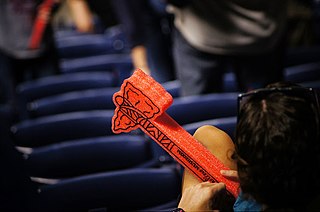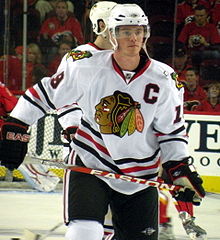
The Chicago Blackhawks are a professional ice hockey team based in Chicago. The Blackhawks compete in the National Hockey League (NHL) as a member of the Central Division in the Western Conference and have won six Stanley Cup championships since their founding in 1926. They are one of the "Original Six" NHL teams, along with the Detroit Red Wings, Montreal Canadiens, Toronto Maple Leafs, Boston Bruins, and New York Rangers. Since 1995, the team has played their home games at the United Center, which they share with the National Basketball Association's Chicago Bulls; both teams previously played at the now-demolished Chicago Stadium.

Chief Illiniwek was the symbol of the University of Illinois Urbana-Champaign (UIUC), associated with the university's intercollegiate athletic programs, from October 30, 1926, to February 21, 2007. Chief Illiniwek was portrayed by a student to represent the Illiniwek, the state's namesake, although the regalia worn was from the Sioux. The student portraying Chief Illiniwek performed during halftime of Illinois football and basketball games, as well as during women's volleyball matches.
Indian Head can refer to:

Thomas James Lysiak was a Canadian professional ice hockey player. Selected in the first round, second overall, of the 1973 NHL Amateur Draft by the Atlanta Flames, he was additionally selected by the Houston Aeros in the second round of the 1973 WHA Amateur Draft at 23rd overall.

Maj. Frederic McLaughlin was an American businessman and soldier. He was the first owner of the Chicago Black Hawks National Hockey League (NHL) ice hockey team.
Frederick Sasakamoose, was a Canadian professional ice hockey player. He was one of the first Canadian Indigenous players in the National Hockey League, and the first First Nations player with treaty status. He played 11 games with the Chicago Black Hawks during the 1953–54 season; the rest of his career, which lasted from 1953 to 1960, was spent in various minor leagues. After his playing career, Sasakamoose became involved in Indigenous affairs, and served as chief of the Ahtahkakoop Cree Nation for a period. He was later recognized for his work, including being named a member of the Order of Canada.

Stereotypes of Indigenous peoples of Canada and the United States of America include many ethnic stereotypes found worldwide which include historical misrepresentations and the oversimplification of hundreds of Indigenous cultures. Negative stereotypes are associated with prejudice and discrimination that continue to affect the lives of Indigenous peoples.

Since the 1960s, the issue of Native American and First Nations names and images being used by sports teams as mascots has been the subject of increasing public controversy in the United States and Canada. This has been a period of rising Indigenous civil rights movements, and Native Americans and their supporters object to the use of images and names in a manner and context they consider derogatory. They have conducted numerous protests and tried to educate the public on this issue.
The 1926–27 Chicago Black Hawks season was the team's first season. Chicago was awarded an NHL franchise. Most of the team's players came from the Portland Rosebuds of the Western Canada Hockey League, which had folded the previous season. The team would qualify for the playoffs in their first season, but lost in a 2-game total goal series.

The Washington Redskins name controversy involved the name and logo previously used by the Washington Commanders, a National Football League (NFL) franchise located in the Washington metropolitan area. In the 1960s, the team's longtime name—the Redskins—and the associated logo began to draw criticism from Native American groups and individuals. The topic, part of the larger Native American mascot controversy, began receiving widespread public attention in the 1990s. In 2020, the team responded to economic pressure in the wake of the George Floyd protests by retiring the name and logo. The team called itself the "Washington Football Team" before rebranding as the Commanders in 2022.
The Blackhawks–Red Wings rivalry is a historic rivalry in the National Hockey League (NHL) between the Chicago Blackhawks and Detroit Red Wings. Prior to the 2013–14 league-wide divisional realignment, it was the most intense rivalry in the Central Division during the post-lockout era. They represent the two largest metro areas in the Midwest and are only separated by a 280-mile stretch of road, mostly covered by I-94. The clubs began playing each other in 1926–27, during the inaugural season for both franchises. These two clubs have faced each other in more regular season games than any other two teams in NHL history, only the Bruins–Canadiens rivalry exceeds them in total games played when Stanley Cup playoff games are included.

Scott Darling is an American former professional ice hockey goaltender. He previously played in the National Hockey League (NHL) for the Chicago Blackhawks and Carolina Hurricanes. Darling was selected by the Phoenix Coyotes in the sixth round, 153rd overall, of the 2007 NHL Entry Draft.
Sports teams named Redskins are part of the larger controversy regarding the use of Native American names, images and symbols by non-native sports teams. Teams of this name have received particular public attention because the term redskin is now generally regarded as disparaging and offensive.
In 2005 the National Collegiate Athletic Association (NCAA) distributed a "self evaluation" to its member institutions for teams to examine the use of potentially offensive imagery with their mascot choice. This examination was done in accordance with NCAA policy that requires each member institution to maintain an "atmosphere of respect for and sensitivity to the dignity of every person." Fourteen schools either removed all references to Native American culture or were deemed not to have references to Native American culture as part of their athletics programs. Subsequently, 19 teams were cited as having potentially "hostile or abusive" names, mascots, or images, that would be banned from displaying them during post-season play, and prohibited from hosting tournaments.

The Cleveland Indians name and logo controversy referred to the controversy surrounding the club name and logo previously used by Major League Baseball's Cleveland Guardians, an American professional baseball team based in Cleveland, Ohio.
The Kansas City Chiefs is one of the professional sports teams involved in the controversy regarding the use of Native American names and imagery, but received less attention than other teams until 2013 when fan behavior at games, including stereotypical headdresses, face paint, performing a "war chant" and tomahawk chop became more publicly known. Protests by change advocates intensified following the name changes of the Washington Commanders and Cleveland Guardians. In addition, the Chiefs have been highly visible due to their participation in the Super Bowl in the 2019, 2020, 2022, and 2023 seasons and widespread media coverage. Native American groups demonstrated outside the stadium hosting Super Bowl LVII.










